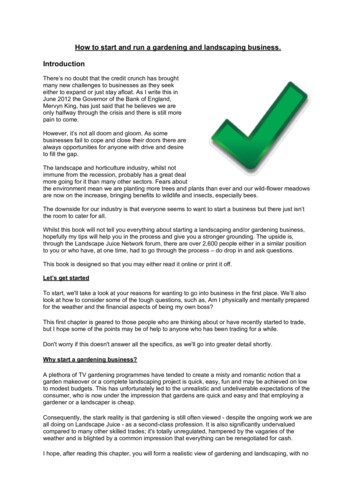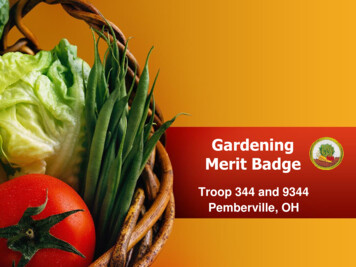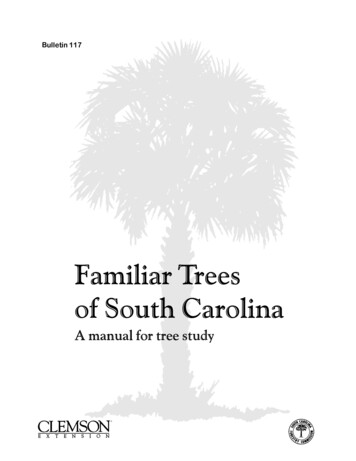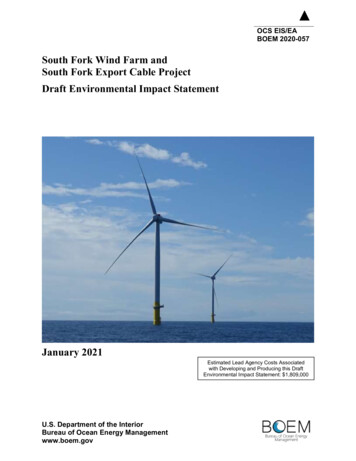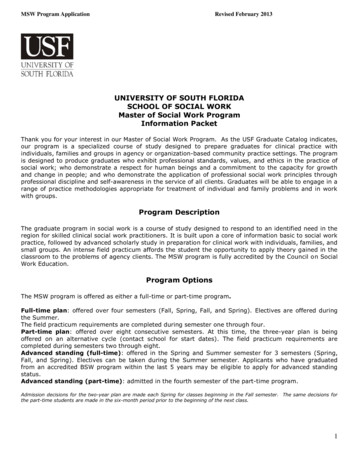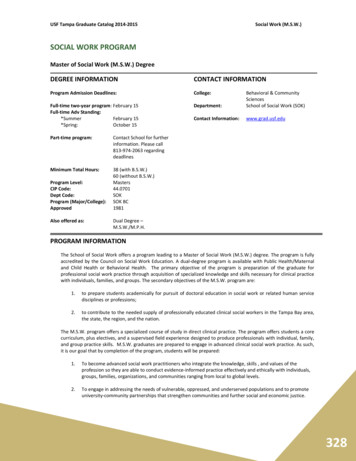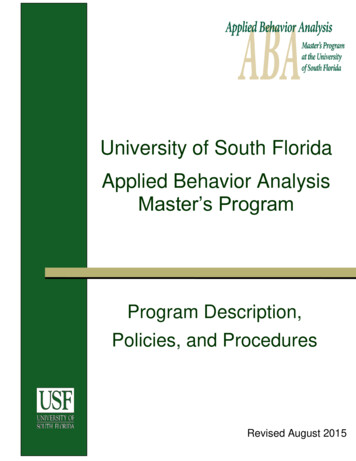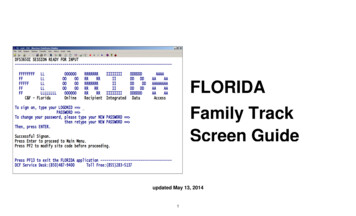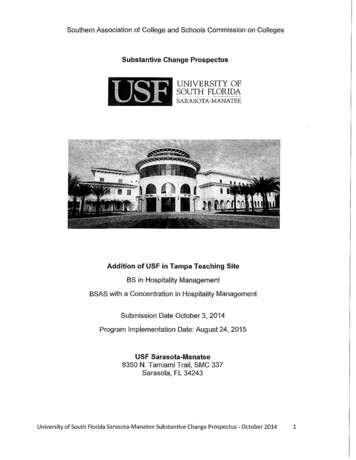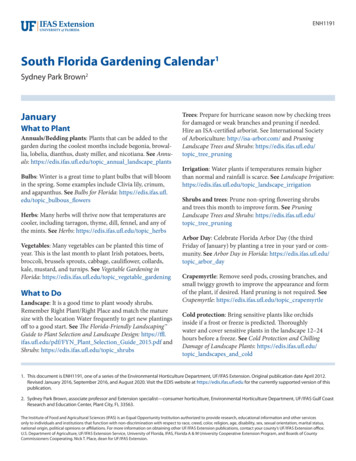
Transcription
ENH1191South Florida Gardening Calendar1Sydney Park Brown2JanuaryWhat to PlantAnnuals/Bedding plants: Plants that can be added to thegarden during the coolest months include begonia, browallia, lobelia, dianthus, dusty miller, and nicotiana. See Annuals: https://edis.ifas.ufl.edu/topic annual landscape plantsBulbs: Winter is a great time to plant bulbs that will bloomin the spring. Some examples include Clivia lily, crinum,and agapanthus. See Bulbs for Florida: https://edis.ifas.ufl.edu/topic bulbous flowersHerbs: Many herbs will thrive now that temperatures arecooler, including tarragon, thyme, dill, fennel, and any ofthe mints. See Herbs: https://edis.ifas.ufl.edu/topic herbsVegetables: Many vegetables can be planted this time ofyear. This is the last month to plant Irish potatoes, beets,broccoli, brussels sprouts, cabbage, cauliflower, collards,kale, mustard, and turnips. See Vegetable Gardening inFlorida: https://edis.ifas.ufl.edu/topic vegetable gardeningWhat to DoLandscape: It is a good time to plant woody shrubs.Remember Right Plant/Right Place and match the maturesize with the location Water frequently to get new plantingsoff to a good start. See The Florida-Friendly Landscaping Guide to Plant Selection and Landscape Design: https://ffl.ifas.ufl.edu/pdf/FYN Plant Selection Guide 2015.pdf andShrubs: https://edis.ifas.ufl.edu/topic shrubsTrees: Prepare for hurricane season now by checking treesfor damaged or weak branches and pruning if needed.Hire an ISA-certified arborist. See International Societyof Arboriculture: http://isa-arbor.com/ and PruningLandscape Trees and Shrubs: https://edis.ifas.ufl.edu/topic tree pruningIrrigation: Water plants if temperatures remain higherthan normal and rainfall is scarce. See Landscape Irrigation:https://edis.ifas.ufl.edu/topic landscape irrigationShrubs and trees: Prune non-spring flowering shrubsand trees this month to improve form. See PruningLandscape Trees and Shrubs: https://edis.ifas.ufl.edu/topic tree pruningArbor Day: Celebrate Florida Arbor Day (the thirdFriday of January) by planting a tree in your yard or community. See Arbor Day in Florida: https://edis.ifas.ufl.edu/topic arbor dayCrapemyrtle: Remove seed pods, crossing branches, andsmall twiggy growth to improve the appearance and formof the plant, if desired. Hard pruning is not required. SeeCrapemyrtle: https://edis.ifas.ufl.edu/topic crapemyrtleCold protection: Bring sensitive plants like orchidsinside if a frost or freeze is predicted. Thoroughlywater and cover sensitive plants in the landscape 12–24hours before a freeze. See Cold Protection and ChillingDamage of Landscape Plants: https://edis.ifas.ufl.edu/topic landscapes and cold1. This document is ENH1191, one of a series of the Environmental Horticulture Department, UF/IFAS Extension. Original publication date April 2012.Revised January 2016, September 2016, and August 2020. Visit the EDIS website at https://edis.ifas.ufl.edu for the currently supported version of thispublication.2. Sydney Park Brown, associate professor and Extension specialist—consumer horticulture, Environmental Horticulture Department, UF/IFAS Gulf CoastResearch and Education Center, Plant City, FL 33563.The Institute of Food and Agricultural Sciences (IFAS) is an Equal Opportunity Institution authorized to provide research, educational information and other servicesonly to individuals and institutions that function with non-discrimination with respect to race, creed, color, religion, age, disability, sex, sexual orientation, marital status,national origin, political opinions or affiliations. For more information on obtaining other UF/IFAS Extension publications, contact your county’s UF/IFAS Extension office.U.S. Department of Agriculture, UF/IFAS Extension Service, University of Florida, IFAS, Florida A & M University Cooperative Extension Program, and Boards of CountyCommissioners Cooperating. Nick T. Place, dean for UF/IFAS Extension.
Pests: Apply horticultural oil to citrus, shrubs, anddeciduous fruit trees while plants are dormant to controlscale. Apply copper spray to mangoes after bloom. SeeLandscape Pest Management: https://edis.ifas.ufl.edu/topic landscape pestsFigure 2. Eggplant.Credits: Tyler Jones, UF/IFASWhat to DoFigure 1. Cattleya orchid.Credits: UF/IFAS Photo by Thomas WrightFebruaryWhat to PlantAnnuals/Bedding plants: Good performers in southFlorida’s mild winter include impatiens, verbena, dianthus,strawflower, and lobelia. See Annuals: https://edis.ifas.ufl.edu/topic annual landscape plantsBulbs: Many bulbs can be planted now. Divide large,crowded clumps. Provide adequate water for establishment. Some examples include Amazon lily, crinum, andagapanthus. See Bulbs for Florida: https://edis.ifas.ufl.edu/topic bulbous flowersGroundcovers: Consider replacing areas of grass withdrought-tolerant, low-maintenance groundcovers. SeeThe Florida-Friendly Landscaping Guide to Plant Selection and Landscape Design: https://ffl.ifas.ufl.edu/pdf/FYN Plant Selection Guide 2015.pdf and Ground Covers:https://edis.ifas.ufl.edu/topic ground coversVegetables: Winter vegetable gardening is in full swing.Last month to plant cantaloupes, cucumbers, eggplant,lettuce, peppers, spinach, and tomatoes for a late springharvest. Protect crops in the unlikely event of a frost orfreeze. See Vegetable Gardening in Florida: https://edis.ifas.ufl.edu/topic vegetable gardeningSouth Florida Gardening CalendarLawns: Fertilize lawn grasses to improve color or coverage.Choose a fertilizer (not a “weed and feed”) with 0% or verylittle phosphorus unless a soil test indicates the need forit. A fertilizer with controlled-release nitrogen provideslonger-lasting results. See Lawn Fertilizer: https://edis.ifas.ufl.edu/topic lawn fertilizationRoses: Prune roses this month to remove damaged canesand improve the overall form. After pruning, fertilize andapply a fresh layer of mulch. Blooming will begin 8–9 weeksafter pruning. See Roses: https://edis.ifas.ufl.edu/topic roseShrubs and palms: Fertilize shrubs and palms by spreadingfertilizer evenly over the soil surface and watering it in.Follow with a fresh layer of mulch to conserve moistureand reduce weeds. Delay pruning any cold-damagedbranches until new growth starts. See Palm Nutrition andFertilization: https://edis.ifas.ufl.edu/topic palm nutritionand Landscape Fertilization: https://edis.ifas.ufl.edu/topic landscape fertilizationLawns: Apply a preemergence weed killer (not a “weed andfeed”) to lawns late this month to prevent germination ofwarm-season weed seeds. Apply when temperatures rise to65 F for 4–5 days. Timing is important for good control.See Lawn Weeds: https://edis.ifas.ufl.edu/topic lawn weedsAvocados and mangoes: Disease-susceptible varieties ofavocado and mango may require applications of copperfungicide. See Avocado: https://edis.ifas.ufl.edu/topic avocado and Mango: https://edis.ifas.ufl.edu/topic mangoCitrus: Fertilize now if not done in January. Frequencyand amount of fertilization depend on the age of thetree. See Home Citrus Culture: https://edis.ifas.ufl.edu/topic citrus home citrus culture2
Trees: Don’t wait until hurricane season to check yourtrees. Hire an ISA-certified arborist to do an inspection.See International Society of Arboriculture: http://isa-arbor.com/ and Pruning Landscape Trees and Shrubs: https://edis.ifas.ufl.edu/topic tree pruningMarchWhat to PlantAnnuals/Bedding Plants: Plant heat-tolerant annuals,such as crossandra, gazania, melampodium, and zinniathat will last into fall. See Annuals: https://edis.ifas.ufl.edu/topic annual landscape plantsBulbs: Plant gladiola corms 6 inches apart and 4 inchesdeep; stake as they grow. Plant caladium for a showytropical display all summer. See Bulbs for Florida: https://edis.ifas.ufl.edu/topic bulbous flowersHerbs: In addition to their culinary value, many herbs areornamental and attract butterflies to the garden. See Herbs:https://edis.ifas.ufl.edu/topic herbsVegetables: This is the last month to plant arugula,beans, cantaloupe, carrots, celery, sweet corn, endive,okra, radish, squashes, Swiss chard, and watermelon. SeeVegetable Gardening in Florida: https://edis.ifas.ufl.edu/topic vegetable gardeningbuds set. See Pruning Landscape Trees and Shrubs: https://edis.ifas.ufl.edu/topic tree pruningMulch: Add mulch to minimize weeds and conservemoisture during dry weather. See Landscape Mulches:https://edis.ifas.ufl.edu/topic mulchLawns: Fertilize lawns this month if not done inFebruary. See Lawn Fertilizer: https://edis.ifas.ufl.edu/topic lawn fertilizationPests: Monitor landscape plants for insects, especially forthe presence of aphids on tender new growth. Insects become more active during warm weather. See Landscape PestManagement: https://edis.ifas.ufl.edu/topic landscape pestsFertilize: Fertilize palms and ornamental shrubs ifnot done last month. See Palm Nutrition and Fertilization: https://edis.ifas.ufl.edu/topic palm nutritionand Landscape Fertilization: https://edis.ifas.ufl.edu/topic landscape fertilizationLawns: Identify damaging insects and spot treat early toprevent widespread damage. See Turfgrass Pest Insects:https://edis.ifas.ufl.edu/topic turf pest insectsTropical and subtropical fruits: Add variety and interestto the landscape and table with exotic fruits. See TropicalFruit for the Home Landscape: https://edis.ifas.ufl.edu/topic home tropical fruitCitrus: Squiggly lines in the younger leaves of citrus treesindicate Citrus Leaf Miner (CLM) insects, but there isseldom a need to manage them. Natural enemies in Floridausually keep them in check. See https://edis.ifas.ufl.edu/topic citrus home citrus cultureAprilWhat to PlantAnnuals/Bedding plants: Plant heat-tolerant annuals, suchas coleus, vinca, and portulaca. See Annuals: https://edis.ifas.ufl.edu/topic annual landscape plantsFigure 3. Caladium.Credits: Tyler Jones, UF/IFASWhat to DoShrubs and trees: Prune when new growth begins after theend of the dormant season. To guard next season’s blooms,begin pruning after the last flowers fade but before the newSouth Florida Gardening CalendarBulbs: Cannas thrive in the heat of summer. New varietieshave colorful leaves as well as flowers. See Bulbs for Florida:https://edis.ifas.ufl.edu/topic bulbous flowersHerbs: Some to start now include basil, coriander, cumin,and mint. See Herbs: https://edis.ifas.ufl.edu/topic herbs3
Vegetables: Beans, Chinese cabbage, Southern peas,and sweet potatoes can still be planted. Mulch bedswell and monitor irrigation if the weather is dry. SeeVegetable Gardening in Florida: https://edis.ifas.ufl.edu/topic vegetable gardeningPerennials and bulbs: Divide clumps of bulbs, ornamentalgrasses, or herbaceous perennials to expand or rejuvenategarden beds or to pass along to friends. See Bulbs forFlorida: https://edis.ifas.ufl.edu/topic bulbous flowersand Perennial Landscape Plants: https://edis.ifas.ufl.edu/topic perennialsShrubs: Choose from a wide variety of shrubs to add tothe landscape now. Remember Right Plant/Right Place andmatch the mature size with the location. See The FloridaFriendly Landscaping Guide to Plant Selection & LandscapeDesign: https://ffl.ifas.ufl.edu/pdf/FYN Plant Selection Guide 2015.pdf and Shrubs: https://edis.ifas.ufl.edu/topic shrubsMayFigure 4. Lady beetle.Credits: UF/IFASWhat to DoPlant for Butterflies: Plant flowers of different colors,shapes, sizes, and blooming seasons to provide nectar foradult butterflies and provide host plants for their caterpillars. See Butterfly Gardening: https://edis.ifas.ufl.edu/topic butterfly gardeningPests: Monitor insect activity and learn which bugs damageplants and which do not. See Landscape Pest Management:https://edis.ifas.ufl.edu/topic landscape pestsBeneficials: Identify and conserve beneficial insects. Someinsects should be encouraged in your yard! See BeneficialInsects: https://edis.ifas.ufl.edu/topic beneficial insectsTomatoes: Watch for pests, disease, and nutritionaldisorders on developing tomato plants. See Home TomatoGardening: https://edis.ifas.ufl.edu/topic tomato gardeningPalms: Identify and treat environmental and nutritionaldisorders in palm trees. See Palm Care: https://edis.ifas.ufl.edu/topic palm careOleanders: Inspect chewed or ragged leaves for oleandercaterpillars at work. See Oleander Pest Management: https://edis.ifas.ufl.edu/topic oleander ipmFruits: Propagate fruit crops by air layering and grafting.See Propagating Fruits in Florida: http://www.solutionsforyourlife.com/hot topics/lawn and garden/propagating fruits.shtmlSouth Florida Gardening CalendarWhat to PlantAnnuals/Bedding plants: Plants that can take summerheat include coleus, salvia, torenia, wax begonia, andornamental pepper. See Annuals: https://edis.ifas.ufl.edu/topic annual landscape plantsBulbs: Some lilies do better when their roots are crowded.Try planting Amazon, Aztec, and Clivia lilies in containersto increase blooming. See Bulbs for Florida: https://edis.ifas.ufl.edu/topic bulbous flowersHerbs: Plant heat-loving herbs, including basil, Mexicantarragon, ginger, cumin, summer savory, and rosemary. SeeHerbs: https://edis.ifas.ufl.edu/topic herbsVegetables: Sweet potatoes, boniato, hot peppers, andtropical “spinach” such as Sisso, Malabar, and New Zealandcan be planted now. See Vegetable Gardening in Florida:https://edis.ifas.ufl.edu/topic vegetable gardeningWhat to DoPests: Watch for thrips, scale, and mites on ornamentalplants because they become more active in warm weather.See Landscape Pest Management: https://edis.ifas.ufl.edu/topic landscape pestsGardenias and ixora: Distinguish between the normalyellowing of older leaves and the yellowing of new growth,which usually indicates a micronutrient deficiency. SeeNutrient Deficiency (Landscape Plants): https://edis.ifas.ufl.edu/topic nutrient deficiencies landscape plants andGardenias at a Glance: https://edis.ifas.ufl.edu/ep3384
some coleus. See Annuals: https://edis.ifas.ufl.edu/topic annual landscape plantsPalms: Summer’s warm, rainy months
South Florida Gardening Calendar1 Sydney Park Brown2 1. This document is ENH1191, one of a series of the Environmental Horticulture Department, UF/IFAS Extension. Original publication date April 2012. Revised January 2016, September 2016, and August 2020. Visit the EDIS website at https://edis.ifas.ufl.edu for the currently supported version of this

